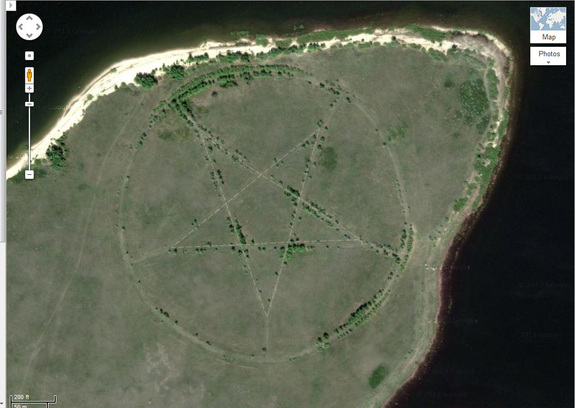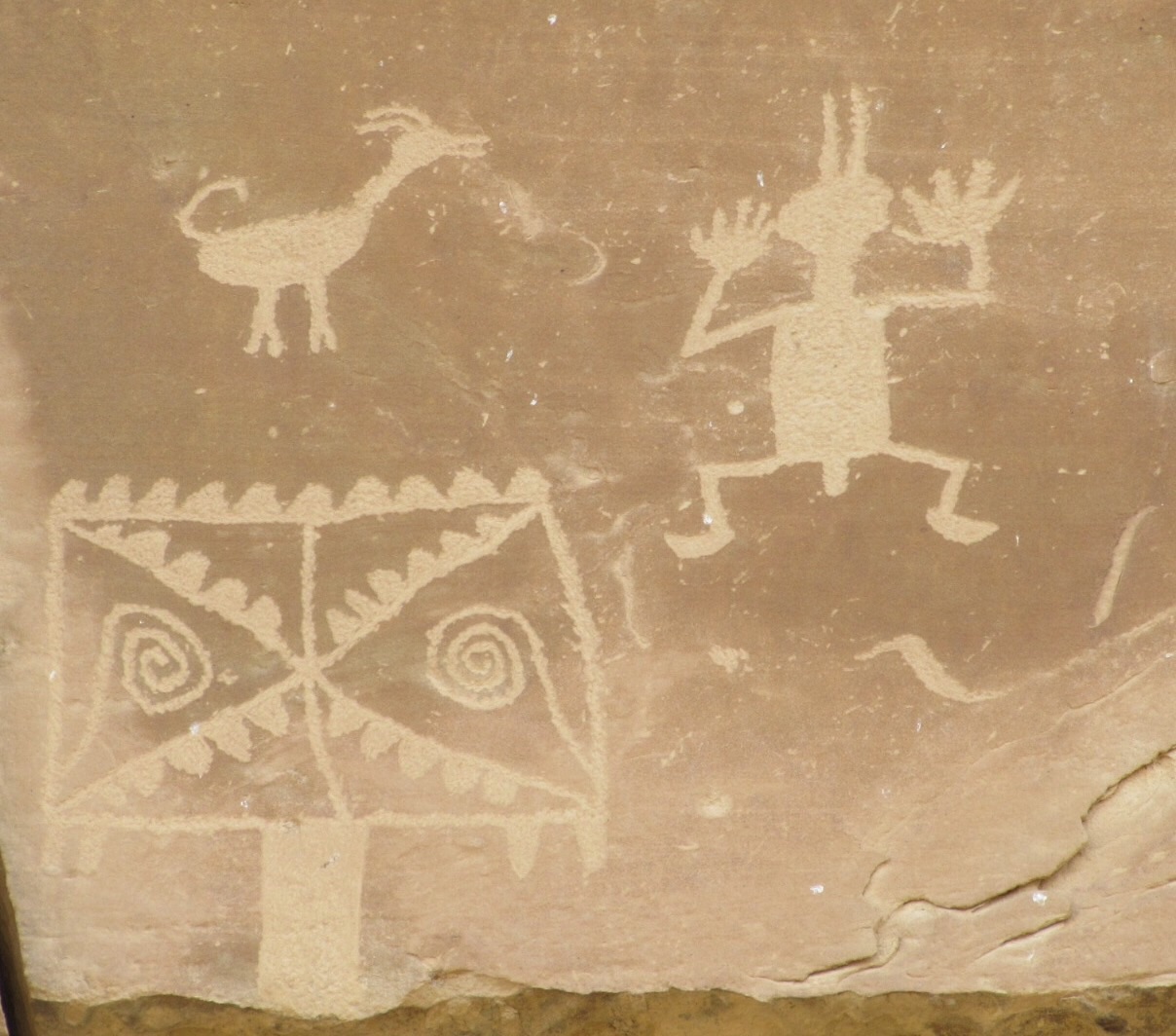It looks like you're using an Ad Blocker.
Please white-list or disable AboveTopSecret.com in your ad-blocking tool.
Thank you.
Some features of ATS will be disabled while you continue to use an ad-blocker.
share:
a reply to: Byrd
Thanks Byrd. That makes a lot of sense. In fact, there was a theme across the entire canyon, pretty much depictions of local wildlife alone travels from pueblo to pueblo along the trail. Supposing an identification of food sources in the vicinity and what to be mindful of. I saw them as billboards for travelers.
Thanks Byrd. That makes a lot of sense. In fact, there was a theme across the entire canyon, pretty much depictions of local wildlife alone travels from pueblo to pueblo along the trail. Supposing an identification of food sources in the vicinity and what to be mindful of. I saw them as billboards for travelers.
Here is a pentagram also found in Kazakhstan:
Pentagram in Kazakhstan
Pentagram in Kazakhstan
edit on 31-10-2015 by bitsforbytes because: (no reason given)
Stranded ET's needed a ride home.
Prob saying "we are here! Land here."
Prob saying "we are here! Land here."
a reply to: Byrd
How cool to have Byrd chime in her knowledge. This thread should be going ballistic.
I don't get it.
My guess would be that it's either a prayer for rain or a ceremony for rain.
How cool to have Byrd chime in her knowledge. This thread should be going ballistic.
I don't get it.
edit on Rpm103115v35201500000024 by randyvs because: (no reason given)
a reply to: bitsforbytes
Live Science

That's very odd (and very modern). Weird?
Though it's difficult to discern from an aerial photograph exactly what the Kazakh pentagram is, Emma Usmanova, an archaeologist with years of experience working in the Lisakovsk area, has an answer. "It is the outline of a park made in the form of a star," Usmanova told LiveScience. The star was a popular symbol during the Soviet era (Kazakhstan was a part of the former Soviet Union until its dissolution in 1991).
Live Science

That's very odd (and very modern). Weird?
originally posted by: Byrd
originally posted by: Rosinitiate
I added above.
a reply to: Hyperia
Here you go again though.
That's Tlaloc (the square thing... Storm Eyes storm god. This is a common depiction of him all over the Southwest) and a shaman and his familiar (mountain goat), which dates the petroglyph to 1500's and afterward (also shown by the relative freshness of the color. Again, in rock art those are a familiar pair and the information that it' s Tlaloc and shaman and familiar come from local tribes (this is known in rock art research.)
My guess would be that it's either a prayer for rain or a ceremony for rain.
Very close approximation.
The "Goat" is a dragon. It is a familiar. The bipedal is the Chaneller, Medium, Mystic, correct. The Square is a doorway, portal, bridge. The spirals inside are vortices from the two eyes, the key.
a reply to: randyvs
a reply to: Byrd
How cool to have Byrd chime in her knowledge. This thread should be going ballistic.
I don't get it.
So lets do it thoroughly, since you complained...
Findings does say, the image to the right, portrayed as a bipedal says a shaman or a high priest
Meaning it was a religious sacrificial ceremony with newborn involved..
a reply to: Byrd
My guess would be that it's either a prayer for rain or a ceremony for rain.
How cool to have Byrd chime in her knowledge. This thread should be going ballistic.
I don't get it.
So lets do it thoroughly, since you complained...
Tlaloc (Classical Nahuatl: Tlāloc [ˈtɬaːlok])[1] was an important deity in Aztec religion; as supreme god of the rains, he was also by extension a god of fertility and of water. He was widely worshiped as a beneficent giver of life and sustenance, but he was also feared for his ability to send hail, thunder, and lightning, and for being the lord of the powerful element of water. Tlaloc is also associated with caves, springs, and mountains, most specifically the sacred mountain in which he was believed to reside. His animal forms include herons and other wet or water dwelling creatures such as amphibians, snails, and possibly sea creatures, particularly ones that inhabit seashells.[2][3] A specific plant also bears a relationship to Tlaloc. Known to the Aztecs as Yauhtli, Tagetes lucida, was burned as a ritual incense in native religious ceremonies.
In Aztec cosmology, the four corners of the universe are marked by "the four Tlalocs" (Classical Nahuatl: Tlālōquê [tɬaːˈloːkeʔ]) which both hold up the sky and function as the frame for the passing of time. Tlaloc was the patron of the Calendar day Mazātl. In Aztec mythology, Tlaloc was the lord of the third sun which was destroyed by fire.
In the Aztec capital Tenochtitlan, one of the two shrines on top of the Great Temple was dedicated to Tlaloc. The high priest who was in charge of the Tlaloc shrine was called "Quetzalcoatl Tlaloc Tlamacazqui." It was the northernmost side of this temple that was dedicated to Tlaloc, the god of rain and agricultural fertility. In this area, a bowl was kept in which sacrificial hearts placed on certain occasions, as offerings to the rain gods.[6] Although Templo Mayor had its northern section dedicated to Tlaloc, the most important site of worship of the rain god was on the peak of Mount Tlaloc, a 4100-meter-high mountain on the eastern rim of the Valley of Mexico. Here the Aztec ruler came and conducted important ceremonies once a year, and throughout the year pilgrims offered precious stones and figures at the shrine. Many of the offerings found here also related to water and the sea
Findings does say, the image to the right, portrayed as a bipedal says a shaman or a high priest
Meaning it was a religious sacrificial ceremony with newborn involved..
edit on 31 10 2015 by Hyperia because: probably a goat
originally posted by: Rosinitiate
a reply to: Byrd
Thanks Byrd. That makes a lot of sense. In fact, there was a theme across the entire canyon, pretty much depictions of local wildlife alone travels from pueblo to pueblo along the trail. Supposing an identification of food sources in the vicinity and what to be mindful of. I saw them as billboards for travelers.
Some of these might also be trail markers. One of the famous trail markers that I saw near Albuquerque was the "parrot trail" (I have forgotten the real name of it), marked with petroglyphs of parrots. It dated to around the 1400's and later and was one of the major trade routes bringing parrot feathers up from Central America to the pueblos. The information signs posted in that part of the park indicated that the petroglyphs were found for hundreds of miles but only along that one trail.
originally posted by: Hyperia
a reply to: beansidhe
this is scientology, i reallly think they are weird..
The pentacle? Yes it is odd. You can see trees planted along the avenues of the star. Is there a scientology group in Kazakhstan?
I wish there was a way of dating the earthworks more accurately, since 1000 - 8000yrs is a massive gap. If it was known when they were created, it would be easier to understand what they might mean.
Magic signs, to be seen from above (by gods that is, not people) or astronomical markers would be my best, non-expert, guess.
originally posted by: Hyperia
How cool to have Byrd chime in her knowledge. This thread should be going ballistic.
I don't get it.
If you have a question, I'll try to answer it.
Meaning it was a religious sacrificial ceremony with newborn involved..
I don't see a newborn there.
My introduction to Tlaloc was through the venerable anthropologist, Eric Wolf (love his studies on power), who had a deep spiritual connection with the deity.
All these mounds, monuments, etc....built by people who didn't write down the why and wherefore of the construction...
Now I see, without benefit of ground-truth examinations---lots of theories about their purpose/origins---so I'll offer mine. Also without the benefit of examination of the actual site.
They were built because teenagers complained of being bored. Parents grew tired of this constant whining and complaining about "nothing to do in this backwater town" and set them to work to build something.
That's my story and I'm sticking to it until somebody actually goes to the site and does a bit of actual investigation.
Now I see, without benefit of ground-truth examinations---lots of theories about their purpose/origins---so I'll offer mine. Also without the benefit of examination of the actual site.
They were built because teenagers complained of being bored. Parents grew tired of this constant whining and complaining about "nothing to do in this backwater town" and set them to work to build something.
That's my story and I'm sticking to it until somebody actually goes to the site and does a bit of actual investigation.
a reply to: diggindirt
That's Rickymouse's theory too for these type of things.
If the good people from Cambridge University Archaeology dept and Vilnius University aren't sure, then I can promise you that my guddling about on the Steppes aren't going to bring us any closer to an answer.
That's Rickymouse's theory too for these type of things.
If the good people from Cambridge University Archaeology dept and Vilnius University aren't sure, then I can promise you that my guddling about on the Steppes aren't going to bring us any closer to an answer.
new topics
-
They Know
Aliens and UFOs: 2 hours ago -
Drones (QUESTION) TERMINATOR (QUESTION)
General Chit Chat: 3 hours ago -
Canada Banning more Shovels
General Chit Chat: 7 hours ago
top topics
-
They Know
Aliens and UFOs: 2 hours ago, 9 flags -
Canada Banning more Shovels
General Chit Chat: 7 hours ago, 8 flags -
The goal of UFO's/ fallen angels doesn't need to be questioned - It can be discerned
Aliens and UFOs: 13 hours ago, 6 flags -
A priest who sexually assaulted a sleeping man on a train has been jailed for 16 months.
Social Issues and Civil Unrest: 13 hours ago, 2 flags -
Drones (QUESTION) TERMINATOR (QUESTION)
General Chit Chat: 3 hours ago, 0 flags
active topics
-
Biden pardons 39 and commutes 1500 sentences…
Mainstream News • 22 • : xuenchen -
I See a Different Attitude This Time Around with Congress
US Political Madness • 17 • : Coelacanth55 -
Jan 6th truth is starting to leak out.
US Political Madness • 24 • : xuenchen -
They Know
Aliens and UFOs • 13 • : alldaylong -
A priest who sexually assaulted a sleeping man on a train has been jailed for 16 months.
Social Issues and Civil Unrest • 16 • : andy06shake -
Post A Funny (T&C Friendly) Pic Part IV: The LOL awakens!
General Chit Chat • 7905 • : underpass61 -
Drones (QUESTION) TERMINATOR (QUESTION)
General Chit Chat • 4 • : BeyondKnowledge3 -
Canada Banning more Shovels
General Chit Chat • 6 • : Flyingclaydisk -
Top Sci Fi/Horror Crossover Movies
Movies • 11 • : BeyondKnowledge3 -
DONALD J. TRUMP - TIME's Most Extraordinary Person of the Year 2024.
Mainstream News • 31 • : Oldcarpy2

